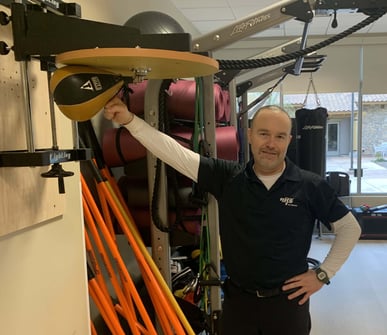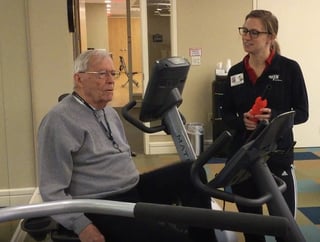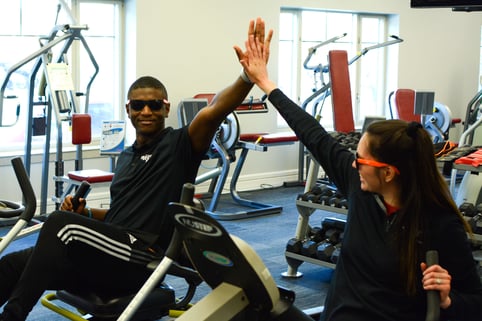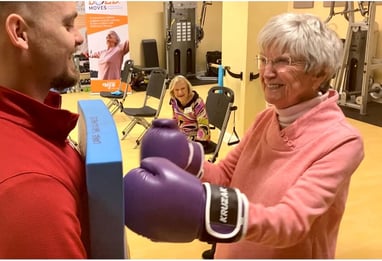.jpg?width=426&height=284&name=GettyImages-623825560%20(1).jpg) Why 10,000 steps a day?
Why 10,000 steps a day?
10,000 steps per day has become a well-known exercise recommendation to achieve better health, but how important is it to aim for that many steps per day? Some people feel that in everyday life, 10k steps isn’t very attainable and while that may feel true, that is exactly why the bar is set so high. Older adults, along with most other age groups live a mostly sedentary lifestyle and walking is one of the simplest exercises that can be recommended for someone looking to get more movement in their day. So why 10,000 steps instead of 1,000 or 5,000? Basically, studies are showing us that the more movement we have, the more our risk for several health issues decreases. For example, this journal was published linking 10,000 steps per day to less cardiovascular disease (heart disease, stroke and heart failure), 13 types of cancer, and dementia. For a healthy, older adult, 7,000-10,000 steps are ideal. However, keep in mind that if you currently live with a disability or chronic illness, your step recommendation may be different. Talk to your doctor before starting an exercise plan and setting a step goal to make sure that is the right plan for you!
Building up to 10,000 steps
The great news is that some steps are better than no steps, but we should all certainly be aiming for more since the average American only gets about 3,000 steps per day! Maybe you are reading this blog because you have been given the goal of 10,000 steps per day, but you aren’t sure how to achieve it. So, let’s talk about it! First, it is probably a good idea to invest in a pedometer. These can be purchased online or in stores or can use your smartphone app (most have a built-in step counter!). Better yet, if you have access to fitness professionals, tap into their knowledge and set a plan.
Here is an example of how NIFS Fitness staff might encourage a member to build steps:
- First, find your baseline. Spend a few days tracking your steps to see what your average per day step count is. Do not try to get more steps on these days because that will skew your actual average.
- Second, focus on adding 250-500 steps each day or every other day so you can feel how your body responds.
- If 250 additional steps each day leaves you feeling sore and fatigued, do not add more steps for 2-3 days, but maintain that additional 250 instead.
- Once your soreness has subsided, add another 250 steps to your daily count.
Creative ways to add steps:
- Are you a member of a fitness center? Take an extra lap around the track or add a 1–2-minute cool down to your treadmill work out.
- Carve out time daily to get outdoors to walk around the block or walk the park path. Invite a friend along.
- Consider setting an alarm to remind you to get up and get moving!
- Going shopping? Park your car a couple of spots further away to add steps (unless it is icy or raining- then you need to park closer!)
- Stuck at home? You can do seated steps! At every TV commercial, sit up straight in your chair and start marching those arms and legs!
Senior living communities with robust fitness centers offer residents a variety of fun and unique ways to stay active along with traditional fitness, like biking, swimming, and strength training so that walking doesn’t have to be the only option to stay active. It is good to become aware of the number of steps you take because it benefits your health and the simple act of being conscious toward your step count is a great start. Having a goal to achieve a certain number of steps each day can have lasting improvements in many aspects of your life and if you find exercises that are fun for you, you will notice that achieving your step goals will be easier. Additionally, the effects of goal setting and attaining those goals you established can improve self-confidence and motivation toward exercise. You can even challenge your friends, family, or peers to see who can reach the highest steps each day. Keeping exercise interesting, fun, and attainable is important to staying engaged and committed to improving your health.
What are some ways you have managed to be less sedentary and get in your steps most days of the week?


.jpg?width=396&height=264&name=GettyImages-1354842116%20(1).jpg) The NIFS staff often find that employees will take time away from their desk to exercise, enjoy conversation that isn't work related, or simply decompress. Our staff are great at putting the FUN into Fitness which often results in laughter during classes, conversations and that sense of community in our client's onsite fitness centers.
The NIFS staff often find that employees will take time away from their desk to exercise, enjoy conversation that isn't work related, or simply decompress. Our staff are great at putting the FUN into Fitness which often results in laughter during classes, conversations and that sense of community in our client's onsite fitness centers.
 Training elements from boxing have become very popular in the active aging segment of the population so it stands to reason that it would be a great training element to include in a senior living fitness program. The benefits when done correctly are immense and include
Training elements from boxing have become very popular in the active aging segment of the population so it stands to reason that it would be a great training element to include in a senior living fitness program. The benefits when done correctly are immense and include 
 There are a lot of news releases lately outlining new construction or expansion projects in senior living. Many of those projects include outfitting a brand new or dramatically overhauled community fitness center.
There are a lot of news releases lately outlining new construction or expansion projects in senior living. Many of those projects include outfitting a brand new or dramatically overhauled community fitness center.

 We have talked about the
We have talked about the 
 The prevalence of Parkinson’s Disease is on the rise. Previous numbers indicated that 60,000 Americans are diagnosed each year and
The prevalence of Parkinson’s Disease is on the rise. Previous numbers indicated that 60,000 Americans are diagnosed each year and 
 We work on a lot of build/design projects in retirement communities where the project is either new construction for a new community, or the plan is part of a repositioning that includes enhanced wellness spaces and services. If you follow industry trends, you see it all the time in press releases, RSS feeds and other media avenues: ground breakings for projects that include a state-of-the-art wellness wing, indoor/outdoor pool complex, etc. Communities are serious about folding resident wellness into their broader business strategy to remain viable in the market. Over my years at NIFS, I’ve had the pleasure of working on dozens of fitness center builds. As you can imagine, I’ve learned quite a bit along the way. Below are our top five recommendations (in random order) on pitfalls to avoid during your design journey.
We work on a lot of build/design projects in retirement communities where the project is either new construction for a new community, or the plan is part of a repositioning that includes enhanced wellness spaces and services. If you follow industry trends, you see it all the time in press releases, RSS feeds and other media avenues: ground breakings for projects that include a state-of-the-art wellness wing, indoor/outdoor pool complex, etc. Communities are serious about folding resident wellness into their broader business strategy to remain viable in the market. Over my years at NIFS, I’ve had the pleasure of working on dozens of fitness center builds. As you can imagine, I’ve learned quite a bit along the way. Below are our top five recommendations (in random order) on pitfalls to avoid during your design journey.